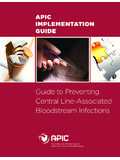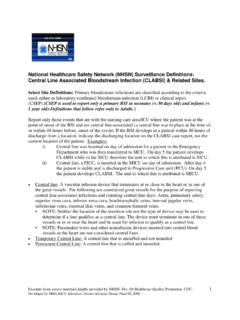Transcription of The pathogenesis of catheter-related Dennis G. Maki ...
1 Intensive Care Med (2004) 30:62 67 DOI SafdarDennis G. MakiThe pathogenesis of catheter-relatedbloodstream infectionwith noncuffed short-termcentral venous cathetersReceived: 2 April 2003 Accepted: 29 September 2003 Published online: 26 November 2003 Springer-Verlag 2003 Supported by an unrestricted gift for re-search from the Oscar Rennebohm Foun-dation of Madison, WisconsinN. Safdar D. G. Maki ())Section of Infectious Diseases,Department of Medicine, Medical School,University of Wisconsin,Madison, WI 53792, USAe-mail: +1-608-2631545 Fax: +1-608-2634464N. Safdar D. G. MakiInfection Control Department,University of Wisconsin Hospitaland Clinics,University of Wisconsin,Madison, WI 53792, USAA bstractObjective:Short-term,noncuffed, percutaneously insertedcentral venous catheters (CVCs) arewidely used and cause more than250,000 bloodstream infections(BSIs) in hospitals each year in theUnited States.
2 We report a prospec-tive study undertaken to determinethe pathogenesis of CVC-related and setting:Prospective co-hort study in a university hospital 24-bed medical-surgical intensive and participants:Pa-tients participating in two random-ized trials during 1998 2000 onestudying the efficacy of a 1% chlor-hexidine 75% alcohol solution forcutaneous antisepsis and the other anovel chlorhexidine-impregnatedsponge dressing formed the studypopulation; CVC-related BSIs wereconsidered to be extraluminally ac-quired if concordance was identifiedsolely between isolates from cathetersegments, skin, and blood culturesand intraluminally acquired if con-cordance was demonstrated only be-tween hub or infusate and bloodculture isolates, as confirmed byDNA subtyping of isolates fromblood and catheter sites or :Of 1,263 catheters (6075 CVC days) prospectively studied, 35( ) caused BSI ( per 1000 CVC days); 27 were caused bycoagulase-negative , 45% of infections were ex-traluminally acquired, 26% wereintraluminally derived, and themechanism of infection was indeter-minate in 29%.
3 In the pooled controlgroups of the two trials, 25 CVC-related BSIs occurred ( per 1000 CVC days), of which 60% of infec-tions were extraluminally acquired,12% were intraluminally derived and28% were indeterminate. In contrast,CVC-related BSIs in the treatmentgroups were most often intralumin-ally derived (60%,p= ).Con-clusions:Most catheter-related BSIswith short-term percutaneously in-serted, noncuffed CVCs were extra-luminally acquired and derived fromthe cutaneous microflora. Strategiesachieving successful suppression ofcutaneous colonization can substan-tially reduce the risk of catheter-related BSI with short-term Central venous catheters PathogenesisIntroductionReliable and safe vascular access is one of the mostessential features of modern medical care. Unfortunately,the intravascular devices needed to establish stable accessare associated with significant potential for producingiatrogenic disease, most often catheter-related bacteremiaor candidemia [1, 2, 3].
4 More than 250,000 intravasculardevice-related bloodstream infections (BSIs) occur in theUnited States each year [1]; the majority are related to63short-term noncuffed, percutaneously placed central ve-nous catheters (CVCs). CVC-related BSIs are associatedwith 12 25% attributable mortality [4, 5, 6, 7], andprolongation of hospital stay [5, 6, 7, 8] and marginal costto the health system of $33,000 35,000 per episode [5, 6,8].Understanding the pathogenesis of CVC-related BSIsis essential to devising strategies for prevention of theseinfections; however, few studies have determined themechanism of CVC-related colonization and infection,particularly using molecular techniques to verify potentialroutes of infection [9, 10, 11, 12, 13, 14, 15]. We report aprospective study which employed molecular epidemiol-ogy to determine the pathogenesis of CVC-related BSIwith short-term, noncuffed CVCs placed percutaneouslyin the internal jugular, subclavian, or femoral total of 1,098 patients participating in two randomized trialsduring 1998 2000 [16, 17] formed the study population.
5 One trialstudied the effect of a 1% chlorhexidine 75% alcohol solution forcutaneous antisepsis for intravascular catheters [17], and the otherevaluated the efficacy of a novel chlorhexidine-impregnated spongedressing for prevention of catheter-related BSI [16]. The two trialswere very similar in overall design and studied common patientpopulations (Table 1). The majority of patients studied were elderlyand had one or more underlying diseases; the mean severity ofillness score (Acute Physiology and Chronic Health Evaluation II)was 22. Most patients had a urinary catheter and were mechanicallyventilated during the period in which they had a study data were obtained for 1,263 CVCs, a total of 6,075 CVCdays. Data were collected prospectively on study patients withnewly inserted short-term, noncuffed and nontunneled centralvenous catheters, including demographic features, underlyingdiseases, Acute Physiology and Chronic Health Evaluation II[18], reason for placement of the catheter, service, antibiotic use,length of hospital stay, number of days the catheter remained inplace, presence of other invasive devices (urinary catheters andendotracheal tubes), and all clinical and laboratory data pertainingto infection.
6 Both studies were approved by the institutional reviewboard, and written informed consent was obtained from all subjectsprior to methodsAt the time of catheter removal, skin of the insertion site wascultured quantitatively, as previously described [19]. For eachcatheter two 5-cm segments, the intracutaneous segment and thetip, each transported in a sterile container, were cultured semi-quantitatively; each hub and fluid aspirated aseptically from themost distal injection port of the line were also cultured quantita-tively, as previously described [19]. Micro-organisms were iden-tified according to standard criteria [20]. When catheter-associatedBSI occurred, isolates recovered from the insertion site, cathetersegments, infusate or hubs, and blood cultures that appeared similarphenotypically were subtyped by pulsed-field gel electrophoresisafter digestion of genomic DNA with restriction endonucleases[21], using a computerized system and Centers for Disease Controlcriteria [22] for determining the relatedness of isolates (Gel Doc2000, Bio-Rad Laboratories, Hercules, Calif.)
7 , USA).DefinitionsCatheter-tip colonization was defined as a positive semiquantitativeculture of an intravascular catheter segment (>15 colony-formingunits) and is considered synonymous with local infection of thecatheter [19]. catheter-related BSI was defined as isolation of thesame strain from the catheter segment, a hub, or infusate and fromone or more blood cultures, as confirmed by restriction-fragmentsubtyping, with no other clearcut source for the BSI [19]. BSIs wereconsidered to be extraluminally acquired if concordance wasdemonstrated solely between isolates from catheter segments, skin,and blood cultures and intraluminally acquired if concordance wasdemonstrated only between isolates from a hub or infusate andblood cultures; if the findings suggested that both routes or neithermight be operative, the pathogenesis of infection was designated methodsThe significance of differences between groups was calculated byc2or Fisher s exact test.
8 We considered two-tailedpvalues lessthan as statistically the 1263 CVCs 333 ( ) were colonized atremoval and 35 ( ) caused CVC-related BSI, anincidence density of per 1000 CVC days. BSIs werecaused by coagulase- negative staphylococci (n=27),enterococci (n=4), enteric Gram-negative bacilli (n=3),orCandida(n=1; Table 2).Recognizing that the database is comprised of patientswho were participating in two randomized trials of novelTable 1 Features of the study population (APACHEA cute Phys-iology and Chronic Health Evaluation;n=1,098)Sex: M/F476/622 Age, mean (years)64 15 Location of catheterSubclavian vein255 ( )Internal jugular vein803 ( )Femoral vein205 ( )Duration of catheterization (days) with more than two lumens46%Host risk factorsDiabetes mellitus13%Malignancy7%Organ transplant11%Trauma6%Granulocytopenia (<1000 mm3)2%APACHE risk factorsUrinary catheters90%Mechanical ventilation83%Prior antibiotics71%Laboratory valuesAlbumin (g/dl) (mmol/l) for prevention of CVC and arterial catheter-related BSI, and that both strategies were found to reducethe incidence of catheter colonization and CVC- andarterial catheter-related BSI [16, 17], the rate of CVC-related BSI was also calculated for the pooled data fromthe control groups [700 CVCs, 3,626 catheter days, 25 CVC-related BSI ( )]
9 , 7 per 1000 catheter days] andthe treatment groups of the two trials [563 CVCs, 2,449catheter-days, 10 CVC-related BSIs ( ), per 1000catheter days].In the overall population studied 45% of CVC-relatedBSIs were extraluminally acquired, 26% appear to havehad an intraluminal origin, and the mechanism ofinfection was indeterminate in 29% (Table 2). In aseparate analysis of BSIs from the pooled data of thetreatment and control groups (Table 3) it can be seen thatthe extraluminal route was most important (60%) for thecatheters in the control groups, but with successfulsuppression of cutaneous colonization by the two strate-gies studied the CVC-related BSIs that occurred in thetreatment groups were much more likely to be intralumi-nal (60%) or indeterminate (30%) in origin (p= ).
10 Arepresentative pulsed-field gel electrophoresis gel show-ing the pathogenesis of a CVC-related BSI is shown inFig. pathogenetic mechanisms were also analyzedaccording to the method of insertion: first catheter in a denovo site and second catheter inserted in an old site over aguidewire; there were no differences between the twogroups (Table 4).Table 2 Microbiology and pre-sumed pathogenesis of 35 cen-tral venous catheter-relatedbloodstream infections, basedon DNA subtyping (extralumi-nalconcordance demonstratedsolely between skin, cathetersegments, and blood cultures,intraluminalconcordance dem-onstrated exclusively between ahub or infusate and blood cul-tures,indeterminatefindingssuggest that neither or bothroutes of infection operative)ExtraluminalIntraluminalIndete rminaten%n%n%Coagulase-negative staphylococci1240830726 Enterococci3751250 Gram-negative bacilli1330 267 Enterobacter cloacae0 0 11 Klebsiella pneumoniae0 0 11 Burkholderia cepacia11000 0 0 1100 Total16459261029 Table 3 Contrasts in the pathogenesis of central venous catheter-related bloodstream infections in the control and treatment groupsof the study population: 1% chlorhexidine 75% alcohol solutionfor cutaneous antisepsis for intravascular catheters [17] or achlorhexidine-impregnated sponge dressing applied to the insertionsite [16]ExtraluminalIntraluminalIndeterminat en%n%n%Control groups1560312728 Treatment groups*110660330*p= vs.







